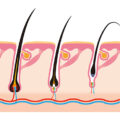Last updated on June 3, 2024

FUE procedures do result in no sutures for the patient, and does have merits in certain circumstances, there is no scientific evidence to support the other claims. FUE is not superior to the more established and widely used surgical technique, Follicular Unit Transplantation (FUT).
FUE and FUT represent different methods of harvesting the donor follicles for transplant and the results achieved are dependent on the skill of the doctor.
FUE, which surgeons often perform with just one or two assistants, involves extracting follicles one at a time using a small punch. The major difficulty with FUE is the use of the small punch prevents the physician from being able to see through the skin and is often referred to as ‘blind harvesting’ of follicles.
The potential consequence of this is limited quality control and a significantly reduced survival rate of the transplanted follicles.
FUE harvesting does not produce the same results as microscopic harvesting and replanting of individual follicles that occurs under FUT.
FUT involves removing a strip of permanent occipital hairs that are microscopically dissected by a team of up to eight technicians.
With a FUT procedure, the patient benefits through a higher survival rate of the transplanted follicles -a transection rate of just two per cent compared to up to 90 per cent for FUE – and healthier hair growth.
The challenge for hair restoration physicians is that a major investment of time and money is required to train a large supporting team of technicians needed to conduct the FUT procedure.
However, any challenges faced by the physician must be secondary to ensuring that the patient receives the most appropriate treatment for their circumstances.








